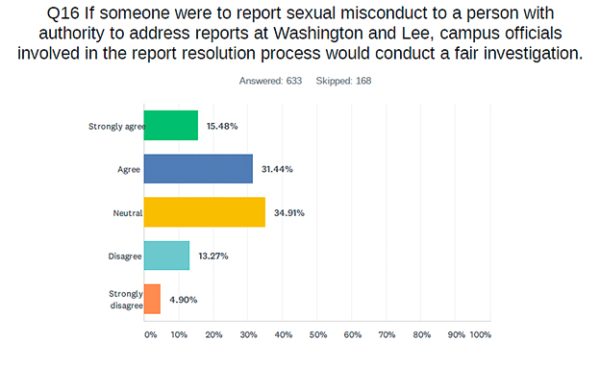Fitness Center policy sparks controversy, conversation
Open forum held to clarify reasoning, expectations regarding gym dress code
W&L community members and Fitness Center staff gather to discuss the dress code controversy. Photo by Ellen Kanzinger, ’18.
May 9, 2016
Recent viral coverage of controversy surrounding Washington and Lee’s gym dress code prompted the W&L Fitness Center staff to hold an open forum Thursday addressing the issue and receive constructive feedback from gym users on campus.
The frustrations with the dress code, which does not allow certain athletic tops whose shape and cut reveal too much skin, were brought to light when an undergraduate student at W&L, who identified herself as Danielle, wrote a blurb about her experience being dismissed from the gym for wearing a lululemon workout top featuring a small triangle cutout that exposed part of her back.
According to a description of gym policies on the W&L Fitness Center’s webpage, “the Fitness Center Director or his/her designee reserves the right to determine whether a user’s attire meets the standard set forth above. Individuals whose attire does not meet this standard may be asked to change. If they fail to comply with a request to change, individuals may be asked to leave the Fitness Center.”
Danielle’s blurb was later tweeted to TotalSororityMove.com, which published a story on her experience implying that the clothing policy was a gender-based issue at W&L.
“Danielle shouldn’t be made to feel bad about her top,” said TotalSororityMove.com writer Cristina Montemayor. “The fitness center director should feel bad for kicking this woman out of the gym just because her top was too ~sexual~ for him to handle. If you get turned on at the mere sight of a woman’s back, well, that sounds like a personal problem to me.”
While Danielle may have been the first to write about her experience and have it catch national media attention, she is not the first student who has felt troubled upon being dismissed from the Fitness Center mid-workout.
Abby Zidell, ‘18, had a similar experience of being asked to leave the gym for wearing an athletic top that showed a portion of her back.
“The way workout clothes are designed today mostly feature little cutouts for style and breathability, and I shouldn’t be punished for wearing clothes that make me feel physically more comfortable when I’m sweating and trying to get a good workout,” said Zidell. “I definitely think this is a gender issue.”
The Fitness Center has responded to the article and criticisms from students like Danielle and Zidell by posting an official statement to their webpage and circulating laminated posters with images outlining appropriate Fitness Center attire. Despite these actions, controversy surrounding the situation did not end.
After TotalSororityMove.com published their article, other publications like Seventeen and Men’s Heath contacted Danielle for a statement. Yahoo, Teen Vogue, Mashable, Daily Mail and other media websites published the story without Danielle’s consent, further contributing to allegations of sexism against the Washington and Lee Fitness Center.
Danielle declined these offers because she does not believe the issue is necessarily related to gender.
“I’m not interested in perpetuating the drama of the situation” she said. “Mostly the changes that needed to be made were made. Now the rules are very clearly outlined.”
Jan Hathorn, Washington and Lee’s Director of Athletics, decided to host an open forum to allow gym-goers an opportunity to give feedback and address all of the issues that arose as a result of the policies.
“It is important to us that our users have the opportunity to speak to us about their concerns, and given all of the media attention and student frustration around this issue, we felt it necessitated hosting an open conversation in a public setting,” said Hathorn.
Hathorn and Fitness Center Director Chris Schall were given the opportunity to deny that the dress code policies had anything to do with gender and were solely in place to protect the health of Fitness Center users and staff.
University Physician Jane Horton supported their claims at the forum by explaining that by wearing clothing during workouts that avoid direct skin contact with surfaces that may become contaminated, the spread of infection can be controlled.
Some students and faculty questioned whether or not the spread of infection could be controlled with different cleaning supplies and a stricter enforcement of users cleaning workout machines after use.
Some students questioned the inconsistencies in dress code policies such as the difference between a small triangle cut out and a completely open back workout top. Students also questioned why some athletic clothing sold at the University Bookstore is no longer deemed compliant with the dress code.
Julia Udicious, ’19, was surprised by the inconsistency associated with her personal experience being dismissed from the gym.
“I was shocked because I have been wearing that exercise top to the gym all year – it followed the dress code as it was described to me at the beginning of the year and I had never been told it was inappropriate before,” said Udicious.
Schall and Hathorn responded by saying they had to be consistent with the rules to be fair to all Fitness Center users, a policy they are continuing to work on. They apologized for the previous lack of communication about the rules and committed themselves to helping students understand why the rules are in place.
“I believe the open forum accomplished some of our objectives to afford users the chance to voice their concerns and discuss their ideas, and to allow for open dialogue” said Hathorn. “I found it to be very informative and greatly appreciate the honesty and forthrightness of everyone who offered their thoughts, concerns, ideas, and suggestions.”













